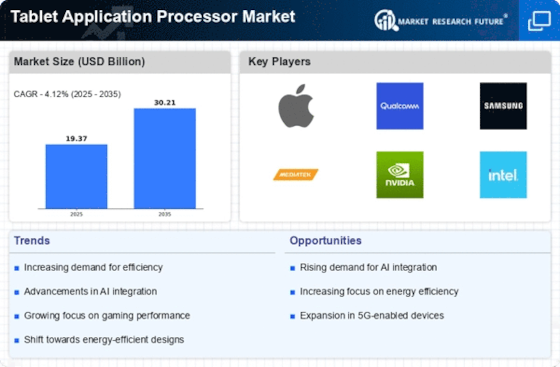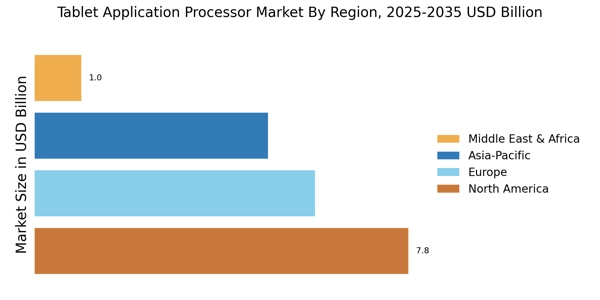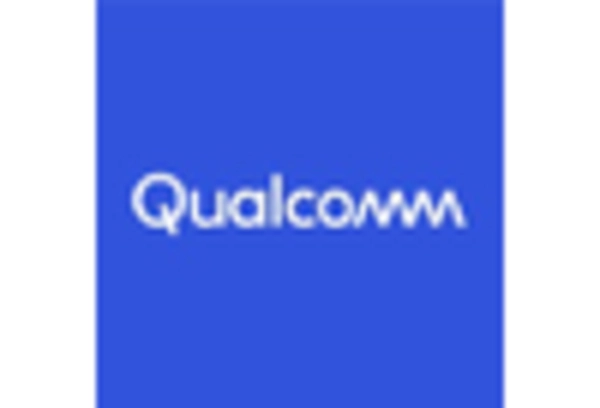Emergence of 5G Technology
The Tablet Application Processor Market is poised for transformation with the emergence of 5G technology, which promises to enhance connectivity and performance. As 5G networks become more widespread, the demand for application processors that can leverage these advancements is expected to grow. In 2025, it is anticipated that over 50% of new tablets will be equipped with 5G capabilities, necessitating processors that can handle increased data speeds and lower latency. This shift encourages manufacturers to innovate and develop processors that not only support 5G connectivity but also optimize overall device performance. The integration of 5G technology is likely to reshape the Tablet Application Processor Market, as users seek devices that can fully utilize the benefits of next-generation connectivity.
Rise of Cloud Computing Services
The Tablet Application Processor Market is being shaped by the rise of cloud computing services, which are transforming how users interact with their devices. As more applications and data migrate to the cloud, the reliance on powerful application processors becomes essential for seamless performance. In 2025, it is projected that cloud-based applications will account for over 70% of tablet usage, necessitating processors that can efficiently manage connectivity and data processing. This shift encourages manufacturers to design processors that optimize cloud performance, ensuring that tablets can handle real-time data access and processing demands. The integration of cloud services into everyday tasks is likely to propel the Tablet Application Processor Market forward, as users increasingly expect their devices to deliver high performance in a cloud-centric environment.
Growing Focus on Gaming Applications
The Tablet Application Processor Market is witnessing a growing focus on gaming applications, which are becoming a primary driver of processor development. As mobile gaming continues to gain popularity, the demand for high-performance application processors that can support advanced gaming features is on the rise. In 2025, the mobile gaming market is expected to surpass 100 billion dollars, highlighting the lucrative opportunities within this sector. Manufacturers are responding by creating processors that offer enhanced graphics capabilities, faster processing speeds, and improved energy efficiency. This trend not only caters to gamers but also attracts a broader audience seeking high-performance tablets. The emphasis on gaming applications is likely to significantly influence the Tablet Application Processor Market, as companies strive to capture the attention of this expanding consumer base.
Increasing Demand for Portable Devices
The Tablet Application Processor Market is experiencing a surge in demand for portable devices, driven by the growing preference for mobile computing solutions. As consumers increasingly seek lightweight and versatile devices, the need for efficient application processors becomes paramount. In 2025, the market for tablets is projected to reach approximately 200 million units, indicating a robust growth trajectory. This trend is further fueled by advancements in mobile technology, which enhance the performance and capabilities of tablets. Consequently, manufacturers are compelled to innovate and develop high-performance application processors that cater to the evolving needs of consumers. The emphasis on portability and functionality is likely to continue shaping the Tablet Application Processor Market, as users demand devices that seamlessly integrate into their daily lives.
Advancements in Multimedia Applications
The Tablet Application Processor Market is significantly influenced by advancements in multimedia applications, which are becoming increasingly sophisticated. As consumers engage with high-definition video streaming, gaming, and augmented reality, the demand for powerful application processors rises. In 2025, it is estimated that over 60% of tablet users will prioritize multimedia capabilities when selecting devices. This trend necessitates the development of processors that can handle complex graphics and high data throughput. Manufacturers are investing in research and development to create processors that not only support these applications but also enhance user experience through improved graphics rendering and processing speed. The growing emphasis on multimedia functionality is likely to drive innovation within the Tablet Application Processor Market, as companies strive to meet consumer expectations.


















Leave a Comment